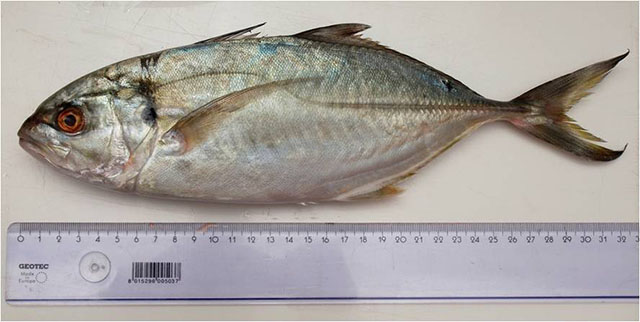| Carangidae (Jacks and pompanos), subfamily: Caranginae |
| 70 cm TL (male/unsexed); max.weight: 5,050.0 g; max. reported age: 11 years |
|
reef-associated; brackish; marine; depth range 0 - 100 m |
| Eastern Atlantic: Senegal to Angola (Ref. 4225, 13121, 57392), including the western Mediterranean, St. Paul's Rocks (Ref. 13121), and Ascension Island. Reported from Mauritania (Ref. 55783). Western Atlantic: Nova Scotia, Canada to Brazil (Ref. 7251), including the Gulf of Mexico (Ref. 9626) and the Caribbean. Also found in Argentina (Ref. 59355). In the tropical Eastern Pacific, it is replaced by Caranx caballus Günther 1869, which may be conspecific. |
|
Dorsal spines (total): 9-9; Dorsal soft rays (total): 22-25; Anal spines: 3-3; Anal soft rays: 19-21. Diagnosis: body elongate (depth comprised 3.2-3.5 times in fork length) and moderately compressed; snout slightly rounded (Ref. 57392). Maxilla ends below middle of eye (Ref. 26938, 57391). 2 dorsal fins, 1st with 8 spines, 2nd with 1 spine and 22-25 soft rays; anal fin with 2 spines, followed by 1 spine and 19-21 soft rays (Ref. 57391, 81654). Anterior lobe of soft dorsal and anal fins moderately developed, their height smaller than head length; pectoral fins falcate, longer than head; scales small and cycloid (Ref. 57391). Chest fully scaled (erroneously reported as chest naked in other sources)(Ref. 81654). 45 (Ref. 26938, 81654) - 56 (Ref. 57392, 81654) scutes along posterior/straight part of lateral line.
Coloration: back light olivaceous to bluish-green, sides silvery-grey to golden; juveniles with about 7 dark crossbars on sides (Ref. 57392). |
| A schooling species (Ref. 5217, 57391) generally not far from the coast (Ref. 5217), in coastal marine and brackish waters to at least 100 m depth (Ref. 57392). Juveniles often found in association with floating Sargassum (Ref. 5217), often entering lagoons and estuaries (Ref. 57392). Adults feed on fishes, shrimps, and other invertebrates. They spawn offshore from January through August (Ref. 26938). Eggs are pelagic (Ref. 4233). Excellent food fish (Ref. 9626); marketed fresh, frozen (Ref. 5521), and salted. Often used for bait (Ref. 26938). Maximum reported total length 550mm in Ref. 57392. |
|
Least Concern (LC); Date assessed: 04 February 2009 Ref. (130435)
|
| reports of ciguatera poisoning |
Source and more info: www.fishbase.org. For personal, classroom, and other internal use only. Not for publication.

